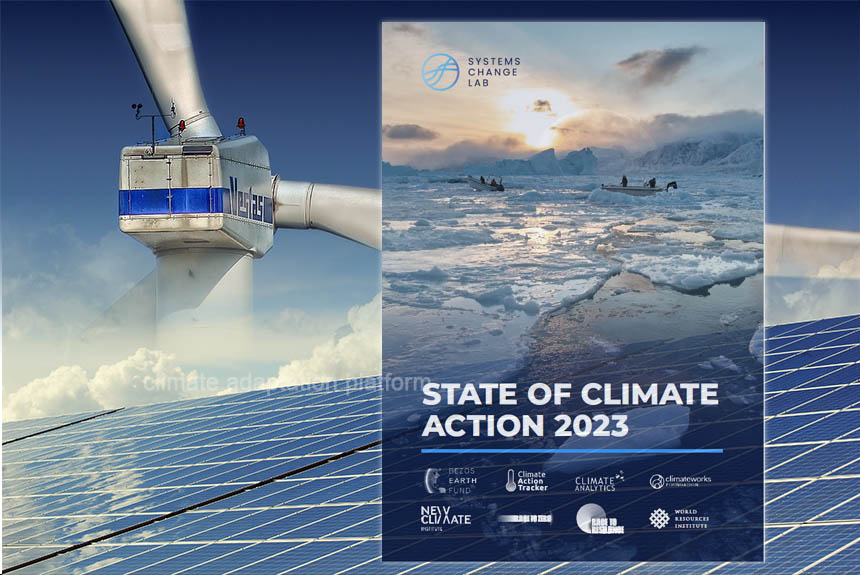We would be confronted by one extreme event after another and with global emissions accelerating instead of slowing down.
On the other, we hear how renewable energy is rapidly expanding and the country’s deployment of climate adaptation or mitigation strategies.
Taking these opposing developments together would make us wonder where the world stands regarding climate actions, leading us to ask these questions:
Are government taking enough actions to curb GHG emissions, and if so, why is it still increasing?
In what areas of climate action are we making progress or failing?
What actions are needed to keep pace with the climate targets?
To help answer these questions and more, a report from The World Resources Institute, State of Climate Action 2023 “provides a comprehensive roadmap of what’s needed by 2030 and 2050 to limit warming to 1.5 degrees C (2.7 degrees F), the limit scientists say is necessary for preventing increasingly devastating and irreversible impacts of climate change (Tracking Climate, 2023).
It sets out the specific targets each sector must hit to achieve Paris Agreement goals and assesses where the world is today (Tracking Climate, 2023).
This year’s analysis shows that of the 42 indicators of progress assessed, only one — sales of electric cars — is on track to reach its 2030 target and help keep 1.5 degrees C within reach” (Tracking Climate, 2023).
Progress for more than half of these indicators also remains off track; worse, actions on another six indicators are heading in the wrong direction.
Lagging climate actions included efforts to end public financing for fossil fuels, significantly reduce deforestation, and expand carbon pricing systems. In 2021, public funding of fossil fuels has risen sharply, nearly doubling from 2020 to reaching the highest levels in almost ten years. Deforestation has also increased to 5.8 million hectares worldwide.
It is not all bad news, however, and there has been encouraging progress in some of the indicators. For instance, electric vehicle passenger car sales grew exponentially at an average annual rate of 65% from 1.6% of sales in 2018 to 10% of sales in 2022, keeping on track with the 2023 targets.
Although insufficient, other indicators going in the right direction include scaling up zero-carbon power, reforestation, and mandatory corporate climate risk.
However, the report highlights that getting all indicators on track is ultimately needed to protect people and nature from extreme natural events’ increasing frequency and intensity.
Below are examples of what the world still needs to do:
- Dramatically increase growth in solar and wind power. The share of these two technologies in electricity generation has grown by an annual average of 14 per cent in recent years, but this needs to reach 24 per cent to get on track for 2030.
- Phase out coal in electricity generation seven times faster than current rates. This is equivalent to retiring roughly 240 average-sized coal-fired power plants annually through 2030. However, the continued build-out of coal-fired power will increase the number of plants that need to be shuttered in the coming years.
- Expand the coverage of rapid transit infrastructure six times faster. This is equivalent to constructing public transit systems roughly three times the size of New York City’s network of subway rails, bus lanes and light-rail tracks each year throughout this decade.
- The annual rate of deforestation — equivalent to deforesting 15 football (soccer) fields per minute in 2022 — needs to be reduced four times faster over this decade.
- Shift to healthier, more sustainable diets eight times faster by lowering per capita meat consumption from cows, goats and sheep to approximately two servings per week or less across high-consuming regions (the Americas, Europe and Oceania) by 2030.
This shift does not require reducing consumption for populations who already consume below this target level, especially in low-income countries where modest increases in consumption can boost nutrition.
Read the report State of Climate Action 2023
Alternatively, click the link to explore WRI’s interactive graphic and read on for eight report findings showing where climate action currently stands across sectors — and what’s needed to get on track.
Source:
Boehm, S., Schumer, C., Grier, E., Jeffery, L., Hecke, J., Jaeger, J., Fyson, C., Levin, K., Nilsson, A., Naimoli, S., Daly, E., Thwaites, J., Lebling, K., Waite, R., Collis, J., Sims, M., Singh, N., Lamb, W., Castellanos, S., Lee, A., Geffray, M., Santo, R., Balehegn, M., Petroni, M., & Masterson, M. (2023, November 14). Tracking Climate Action: How the World Can Still Limit Warming to 1.5 Degrees C. World Resources Institute. Retrieved from https://www.wri.org/insights/climate-action-progress-1-5-degrees-c?utm_campaign=wridigest&utm_source=wridigest-2023-11-15&utm_medium=email
State of the Action Action 2023. (2023, November 14). World Resources Institute. Retrieved from https://www.wri.org/research/state-climate-action-2023
Boehm, S., L. Jeffery, J. Hecke, C. Schumer, J. Jaeger, C. Fyson, K. Levin, A. Nilsson, S. Naimoli, E. Daly, J. Thwaites, K. Lebling, R. Waite, J. Collis, M. Sims, N. Singh, E. Grier, W. Lamb, S. Castellanos, A. Lee, M. Geffray, R. Santo, M. Balehegn, M. Petroni, and M. Masterson. 2023. State of Climate Action 2023. Berlin and Cologne, Germany, San Francisco, CA, and Washington, DC: Bezos Earth Fund, Climate Action Tracker, Climate Analytics, ClimateWorks Foundation, NewClimate Institute, the United Nations Climate Change High-Level Champions, and World Resources Institute. https://doi.org/10.46830/wrirpt.23.00010.



Leave a Reply